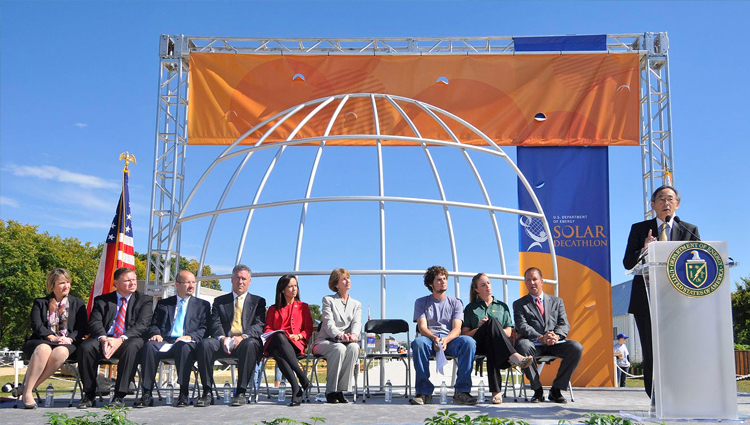Penn State House Part Of National Mall's Solar Village

(Inside Science) -- "It's made of the same material in pizza boxes," assistant professor of energy and mineral engineering at Penn State University Jeffrey Brownson said while pointing to the solar-powered house that he helped to build. "It's the same material, it's just longer chains of carbon."
Brownson was talking about Penn State's solar house Natural Fusion, one of the 20 completely solar-powered structures located within the Solar Village that currently occupies the National Mall in downtown Washington.
Shipped in pieces from universities around the world, the structures are all entries in the 2009 Solar Decathlon, a competition by the Department of Energy to build attractive, energy-efficient solar-powered homes.
"It keeps the pizzas warm," Brownson said, explaining how the materials in the walls of the house absorb heat and reduce the need for air conditioning.
For the past two weeks, this solar shanty town has attracted thousands of tourists, students and politicians. They walk through the unusual neighborhood, lining up for tours and picking their favorites.
"About 2,000 people come through our house each day," Natural Fusion media liaison Thomas Rauch said.
The energy produced by these small structures, each limited to 800 square feet, powers all of the lighting, appliances and air conditioning within. And on sunny days, when the houses produce more electricity than is needed, they pump the extra energy directly into the regional electrical grid that powers the metro area.
Secretary of Energy Steven Chu helped to kick-off the event on Oct. 8 by describing his own home-improvement experiences while working to make his home more energy efficient. "I started doing this long before I knew about climate change. And I have to confess the only reason I was doing that is because I'm fundamentally cheap," he said.
Chu said that during his time at Lawrence Berkeley National Laboratory in California he became convinced that houses could be made 75 or 80 percent more efficient in terms of energy usage -- before adding any solar panels. He also announced an additional $87 million in DOE funding to further the solar research on display in the homes.
Many of the homes look like something out of a science fiction film. The German team built a gleaming black cube with solar panel walls that pumps out twice as much energy as it consumes.
On the other hand, Brownson said that the goal of the Penn State team was "to produce a home that does not alienate a person, that would actually be allowed on a residential block."
The Natural Fusion house is estimated to cost $250,000 to $450,000 to build commercially, less than the $490,000 average cost of a home on this solar block. The cheapest house -- Rice University's ZEROW House -- is intended for lower-income inner-city neighborhoods and is built with walls of galvanized metal that could retail for $140,000. The customized electronics and solar panels in the North House help contribute to a cost upwards of $800,000, a sum that Team Ontario/British Columbia from the University of Waterloo, Ryerson University and Simon Fraser University aim to target at young urban professionals.
Natural Fusion consumes very little energy. On good days, it gives energy back to the grid -- about 2 kilowatt hours -- enough to power 20 incandescent light bulbs for an hour. According to Brownson, the energy is provided by thin films rolled up into tubes that are about $1,000 cheaper than flat solar panels, but generate more consistent power levels. Below the tubes, the roof of the house is lined with plants. As the plants soak in the sunlight, they release moisture that cools the panels, helping to improving their efficiency.
"Ordinarily, you'd have a white roof under the solar panels," Brownson said. "Our thin films allow us to have green roofs."
Several of the houses are smart phone-enabled -- the interior lighting and temperature can be changed remotely with an iPhone application. Others adjust interior conditions automatically, using sensors that monitor time and weather data to tint electrochemical windows and dim light levels.
"If it senses a cold front is moving in or a storm front is moving in, the home basically starts to prepare for that climatic change," said professor Greg Luhan about the house built by the University of Kentucky in Lexington.
But the point of the contest isn't just to showcase new technology. Each team is scored in 10 different categories that include engineering, lighting design, architecture, market viability, comfort, and communications. Though the students don't actually live in their houses (D.C. law prevents this), the houses must provide everything needed for daily living. Several times a day, they pump out 15 gallons of hot water that could be used for showering. The teams also run a suite of appliances that include dishwashers, clothes washers, refrigerators and televisions.
Teams that score well overall are those that focus not only on the individual pieces of the house, but on how the pieces fit together to create a the houses focus on a systems approach -- designing a house not piece by piece, but as a giant system.
"As we went through the 70s and the 80s, we had terribly unreliable systems that gave solar a black eye," said Richard King, director of the Solar Decathlon. "As we move into the future, to do it right we have to start from the ground up and make the whole house a system, so it's all integrated."
"The analogy we're using for our systems approach is the Wright Brothers," Brownson said. "Their systems design didn't need a lot of power to get off the ground. We want to see how low you can go in reducing the amount of power required."
Devin Powell is freelance science journalist based in New York. His stories have appeared online and in print at Nature, Scientific American, the Washington Post, Science News, WIRED, The Best American Science Writing 2012 anthology, and elsewhere.

